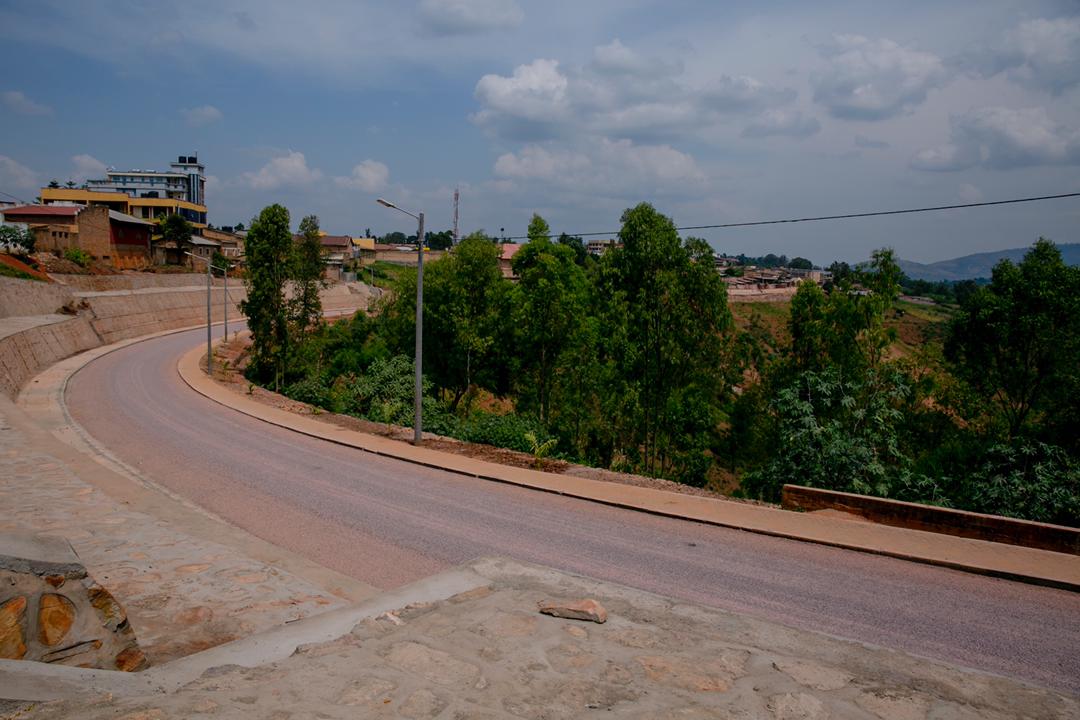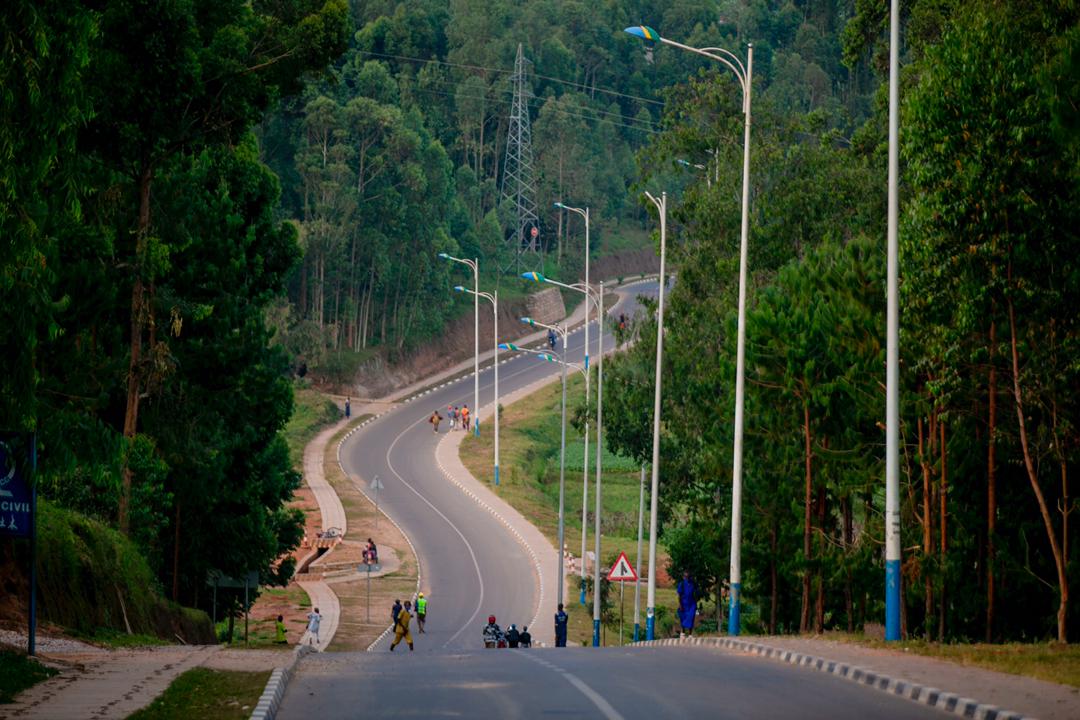
The Rwabayanga gulley in Huye city
On June 7, 2021 a group of eight journalists, photographers and infrastructure ministry officials set off on a two weeks long media tour to six secondary cities.
The important mission was to witness first hand the impact of over Rwf100 billion injected in Rwanda Urban Development Project (RUDP1).
RUDP1 is a five-year (from 2016-2021) World Bank- Government of Rwanda funded infrastructure project prototype intended to construct asphalt roads and drainages in select parts of the City of Kigali and the Six Secondary Cities namely: Huye, Muhanga, Musanze, Nyagatare, Rubavu and Rusizi.
The last time I visited these places, five years ago, they were catalogued as towns and frankly most of them only relied on the main highway that links Rwanda to the border with a neighboring country- Uganda, Burundi and Democratic Republic of Congo(DRC) in most cases.
Or to say the least, the road network and access was but a challenge.
Most of them didn’t have proper roads, drainages, hotels and street lighting electricity in a sense that one would have to travel to Kigali to see the opposite of this.
After we were briefed about the RUDP 1 project goals in these areas, I remained open minded, anxious to see how the activities have changed life in these areas.
In Nyagatare
The first stop was in Nyagatare. I have always known Ntagatare as a dry and dusty remote-plain plateau area neighboring Uganda in the Eastern Province which depends largely on livestock and farming activities.
On arrival, it was evident that natural features and human activity didn’t change in the district, but the formerly dusty unpaved roads had improved to clean paved road connecting the city center, especially at the main bus park road which was known for dust.
“It was almost impossible to do business here with all this potential of neighboring Uganda, vast agriculture and livestock business, but now we can have livestock products like milk transported safely,” says Mayor David Mushabe.
Though Nyagatare still has idle plots in the city and outskirts, the 1st and 2nd phases of roads under RUDP have connected key areas such as hospitals, schools and markets and construction of commercial houses and modern housing can be seen along the new roads.
In Nyagatare one can see livestock for sale near the new city market (Agakiriro) which is also connected with new roads to ease movement of farmers and business in and outside the market.
Geremain Habakurinda, who owns a multimillion hardware shop and lodging facilities next to Nyagatare Hospital says he was moved to invest in a third commercial mansion worth over Rwf200million because of the promise of business brought by new roads.
This boom in activity has increased district revenue for example from Rwf772million to Rwf6.1billion from financial years 2015-2016 to 2019-2020.
Musabe says the next phase of 6.7Km roads planned under RUDP 2, Nyagatare attract citizen’s land use, increase personal security especially for university students and business as the RUDP roads will connect to the national road network on the 73kms Nyagatare – Rukomo road connecting to Musanze district.
In Musanze
From Nyagatare we head to Musanze hitting a four-hour dusty Nyagatare – Rukomo road, a national road, currently under construction and giving promising signs of near completion as the Chinese contractors battle cracking through the mountainous and building bridges in northern hills where the road meanders.
We reached Musanze, a tourist destination in Rwanda known for its conserved mountain gorillas, high end hotel facilities and a booming business.
With this picture, it’s very unlikely RUDP roads could change much but a visit in neighborhoods where new roads and drainage were constructed you get a feel of how mountains have also been a danger to existing infrastructure.
For example before a proper drainage (0.922KM) and bridge was constructed it was life and death choice to cross from Byimana-Muhe villages in Ruhengeri cell (which connect Musanze to Rubavu).
Residents had to go through a painful crossing exercise on a shaky-rugged wooden bridge most times falling in flood waters as they crossed.
“Mountain waters would pour into nearby rivers and flood into settlements filling up drainages thus making activities inaccessible for pedestrians living in communities below,” said one Emmanuel Bajeni Mpumpuro.
Standing on one of these bridges it’s easy to see how citizens easily cross to homes, hear testimonies of reduced travel time and increased business working hours due to public light along the new roads and bridges.
To have this permanently solved local engineer Lucien Nziyumvira, says RUDP environment protection activities and protection of banks of Rwebeya River will continue in phase 3 with construction of Rwebeya standalone drainage (1km).
Nziyumvira says this drainage phase will be crucial as it will control flood water from the main Musanze highway, modern market, and tax park area and Regina Pacis School in the city of Musanze.
Muhanga and Huye
The southern business cities of Muhanga and Huye, connected by a major highway (Kigali-Akanyaru), are relatively developed on the main road and close to Kigali.
Going off the highway here, five years ago, one would see unplanned settlements and business only centralized to the main roads.
With the RUDP roads and drainage in these settlements, the infrastructure have not only changed the image of the cities in terms of new, clean and planned settlement with green beauty and security for citizens, but also in terms of value for land and choices of living outside Kigali.

Construction of this Cyakabiri -Shyogwe sector road was sponsored by World Bank
A plot of land for a house bought about Rwf800, 000 five years ago, today cost six times more with new paved roads, and growing reversed appetite for urban settlement- where Kigalians choose to live in Muhanga and working in Kigali- a 45minutes drive away.
Jean Claude Mutuyeyezu, who works in Kigali says that improved infrastructure and accessibility in Muhanga city compelled him to shift his family to Muhanga six years ago because it’s cheaper to travel back and forth.
This human movement has attracted major investments in housing and industry. For example, construction of three major factories (saucepans, tiles and hygiene equipment) are underway in the 57-hectare Muhanga industrial area.
Besides ease of business and traveling, Muhanga citizens have started adopting close-to- Kigali lifestyles of enjoying new paved roads by jogging and cycling- something that was unknown back then.
Like Musanze, both cities have mastered a new way of managing flood related disasters.
For instance, during the RUDP roads planning and construction, Eng. Onesphore Nzabonimpa says they focused on using drainages that divert over 30,000 cubic meters of roadside rain water into the nearest valleys, swamps and wetlands.
“This is a new method which ensures the rain water doesn’t destroy the roads but is used to water farmland for agricultural purposes and retain the water ecosystem,” Nzabonimpa said.
In a special way, Muhanga city has managed to beat the heavy rains, disaster related accidents and avoid the risks of roads wearing out so soon due to poor drainage.
If you lived in Huye three years ago and know the story of the impassible Rwabayanga valley- known as a “den of thieves” connecting Huye to Ngoma sector, where gangs robbed citizens of their property and dashed into the gulley in the valley, a new story is being written.
The place which was also prone to a landslide due its valley location, now has a new road and drainage. Though lights have not been installed citizens can be seen crossing without fear of being robbed or swept in mudslide, a fear that gangs banked on.
Former gangsters lament the coming of the RUDP infrastructure which took away their ‘robbing net’ but for victims they are proud most of the gang members have been arrested or shifted to far areas.
Rusizi and Rubavu
When I visited Rusizi in 2006, it had a handful of reasonable hotels, but many lodges and by 8pm the town would go to sleep, despite its Lake Kivu shoreline potential and bordering DR Congo where cross border business booms.
For visitors, decent accommodation was located 10 minutes out the city, on a dusty muddy road with no lights and lodges were the better choice.
Father Benjamin Bapfakurera, the Manager at Centre Pastoral Inshuti hotel located over Lake Kivu; says as a result of lack of proper road networks they received few enduring visitors and run accommodation until RUDP roads were constructed in the Camp Cyangugu compelling them to increase from 15 rooms to 60 rooms.
12 years later, entering Rusizi, I was shocked when I almost failed to get a hotel room from more than ten new hotels hand-counted, and human traffic, business remained active beyond 8pm with the new city a modern market and cross border market.
In Rubavu, another border city 6-hours’ drive away in the volcanic mountain ranges, the business boom story is almost the same, not for hotels but RUDP access roads to markets and the border posts with 50-60,000 human cross border traffic per day.
Traders at one of the major oldest markets (MbugaNgari) who got a road and lights connecting it to Petite Bariere post reminisce of old days when they struggled with walk through and transport of goods on volcanic footpaths incurring more costs while truck owners suffered tire bursting.
The executing RUDP in the volcanic activity prone area, the same volcanic stones have been used as baselines for road surface and drainages, which Vice Mayor Economic Affairs, Deo Nzabonimpa says will be accompanied by upgrading to volcano-resistant structures to sustain new and existing businesses.


